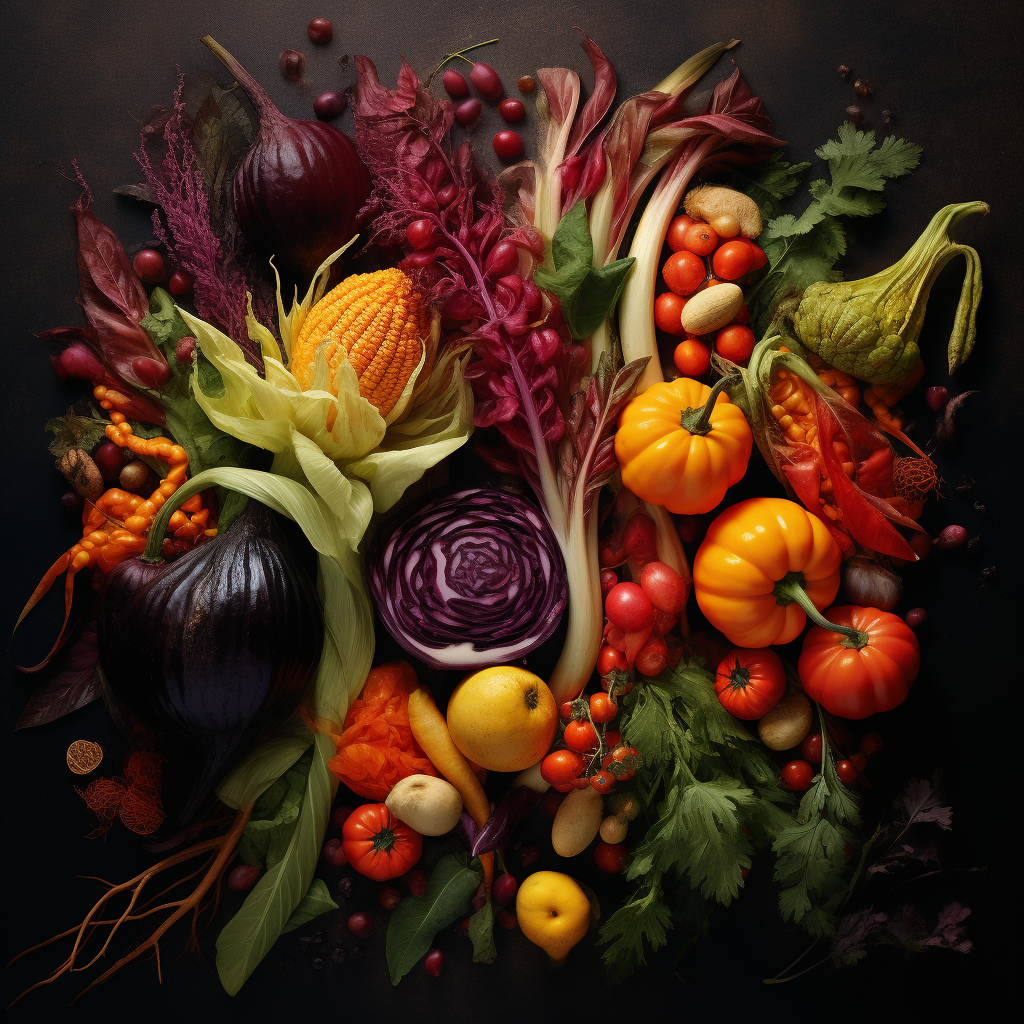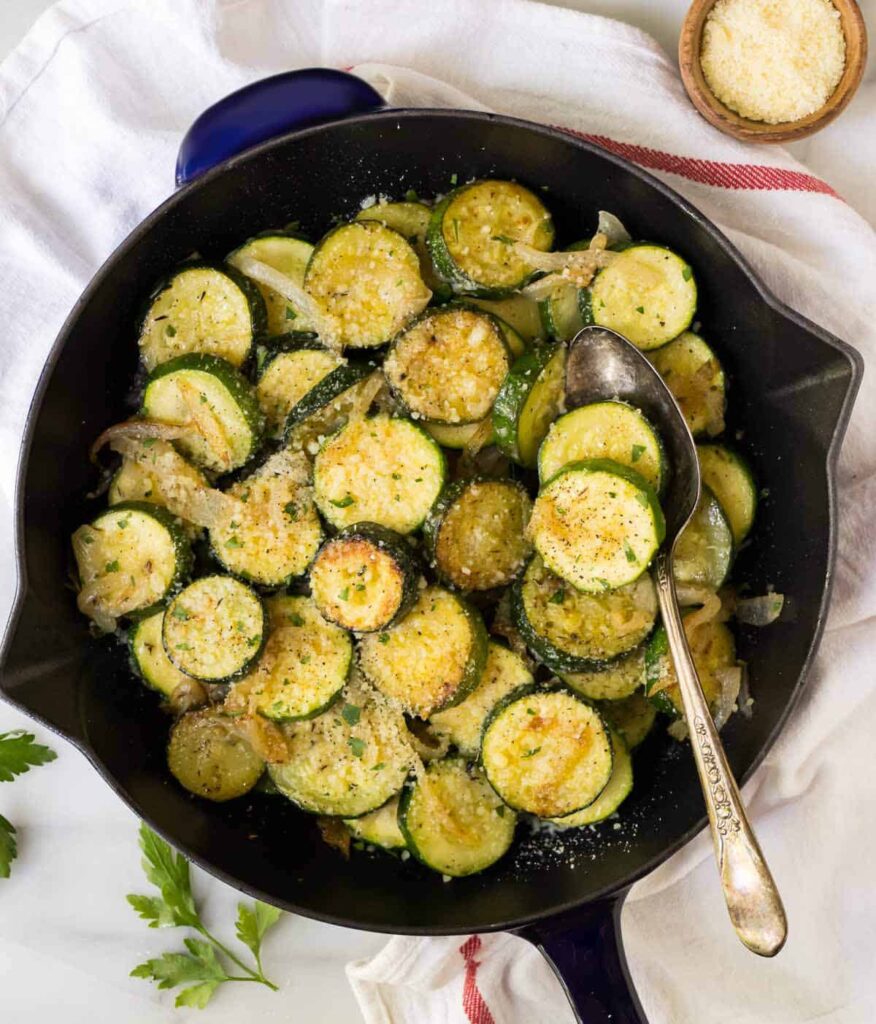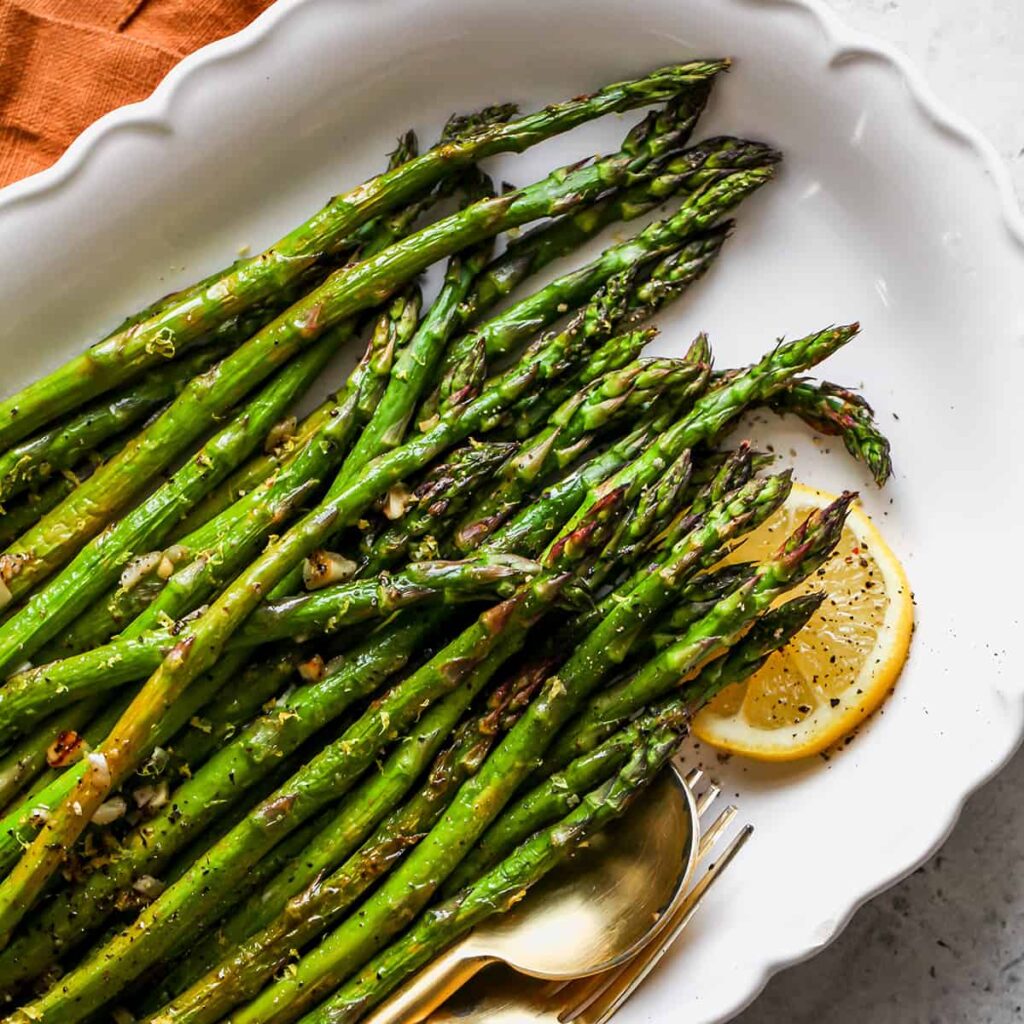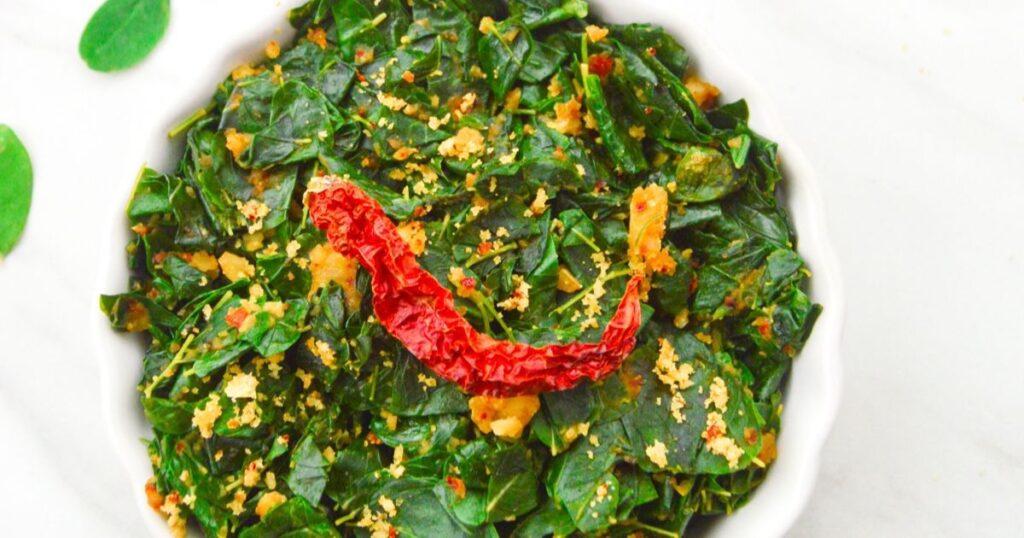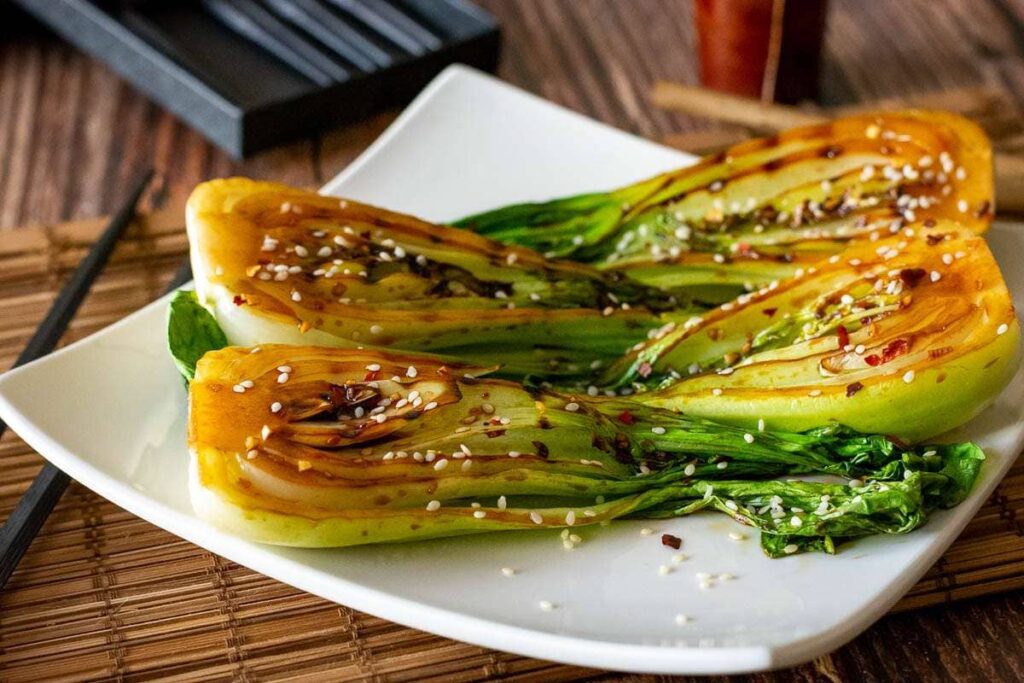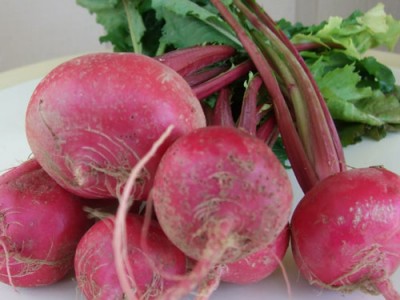
10 Best Vegetables For Autumn Season
Zucchini Vegetable
1)Zucchini Vegetable For Autumn Season:
Scientific Name – Cucurbita Pepo
Zucchini, scientifically known as Cucurbita pepo, is a versatile and popular vegetable enjoyed by people all around the world. Belonging to the gourd family, it is often considered a summer squash due to its tender texture and mild flavor. Zucchini is characterized by its elongated shape and smooth, dark green skin, though there are also yellow and striped varieties available.
Originally hailing from the Americas, zucchini has a rich history that dates back thousands of years, with evidence of its cultivation in Mexico and Central America by ancient civilizations such as the Aztecs and Mayans. It was later introduced to Europe by explorers in the 16th century, and from there, its popularity spread globally.
The culinary appeal of zucchini lies in its versatility and adaptability to various cooking methods. It can be enjoyed raw in salads, sliced and grilled, sautéed, stir-fried, baked into casseroles, and used in soups and stews. Its mild taste allows it to absorb flavors easily, making it a fantastic ingredient in a wide range of dishes.
Apart from being delicious, zucchini is also an excellent addition to a healthy diet. It is low in calories and rich in essential nutrients such as vitamin C, potassium, and dietary fiber. These nutrients contribute to overall well-being, supporting a healthy immune system, heart function, and digestive health.
Furthermore, zucchini is a favorite among gardeners due to its ease of cultivation. It thrives in warm climates and can be grown in both backyard gardens and containers on balconies, making it accessible to people with limited gardening space.
In this article, we will explore the nutritional benefits, culinary uses, and some delightful recipes to savor the goodness of zucchini. Whether you are a seasoned chef or an amateur cook, zucchini’s versatility and health benefits make it a must-have vegetable in your kitchen. So, let’s dive in and discover the wonders of this delightful summer squash
Health Benefits Of Zucchini Vegetable:
- Nutrient-Rich: Zucchini is low in calories but rich in essential nutrients. It contains vitamins A, C, and K, as well as minerals like potassium and manganese. These nutrients support immune function, promote healthy vision, aid in blood clotting, and contribute to overall well-being.
- Fiber for Digestive Health: Zucchini is a good source of dietary fiber, which is important for maintaining a healthy digestive system. Adequate fiber intake can support regular bowel movements and help prevent constipation, a common concern during the autumn season.
- Hydration: Zucchini has a high water content, which can contribute to your hydration during the autumn months when indoor heating and cooler temperatures can lead to dryness. Staying properly hydrated is important for overall health and well-being.
- Antioxidant Power: Zucchini is rich in antioxidants like vitamin C and beta-carotene. These antioxidants help protect the body’s cells from damage caused by harmful free radicals, reduce inflammation, and support a healthy immune system.
- Weight Management: Zucchini is low in calories and high in water and fiber content, making it a great addition to a weight management plan. It can help you feel fuller for longer and support healthy eating habits during the autumn season.
- Versatile Ingredient: Zucchini is a versatile vegetable that can be used in a variety of dishes. It can be eaten raw in salads, spiralized into noodles, grilled, roasted, sautéed, or used as a filling in various recipes. Its mild flavor and adaptable texture make it a versatile ingredient in autumn cooking.
- Seasonal Availability: Zucchini is often harvested during the autumn season, making it readily available and fresh. Consuming locally grown zucchini can ensure you enjoy the maximum nutritional benefits it offers.
Zucchini Used For Home:
- Zucchini Noodles: Use a spiralizer or vegetable peeler to create zucchini noodles, also known as “zoodles.” These can be used as a healthy alternative to pasta in various recipes. Sauté or steam the zoodles and top them with your favorite sauces, such as marinara, pesto, or Alfredo.
- Grilled Zucchini: Slice zucchini into thick strips, brush them with olive oil, and season with salt, pepper, and any desired herbs or spices. Grill the zucchini until tender and slightly charred. Grilled zucchini makes a delicious side dish or can be used in sandwiches, wraps, or salads.
- Stuffed Zucchini: Cut zucchini in half lengthwise and scoop out the seeds to create a hollow cavity. Fill the zucchini with a stuffing of your choice, such as a mixture of ground meat, rice, vegetables, and herbs. Bake in the oven until the zucchini is tender and the stuffing is cooked.
- Zucchini Fritters: Grate zucchini and squeeze out the excess moisture. Mix it with eggs, flour or breadcrumbs, grated cheese, herbs, and seasonings. Form the mixture into patties and pan-fry them until golden brown. Zucchini fritters can be served as a side dish, appetizer, or as a vegetarian burger option.
- Zucchini Bread or Muffins: Grate zucchini and use it as an ingredient in quick bread or muffin recipes. Zucchini adds moisture and a mild sweetness to baked goods. Combine it with flour, sugar, eggs, oil, and spices to create a delicious and moist treat.
- Zucchini Soup: Sauté diced zucchini with onions, garlic, and other desired vegetables. Add vegetable or chicken broth, bring to a simmer, and cook until the zucchini is tender. Puree the mixture until smooth and creamy, and season with herbs and spices of your choice. Zucchini soup can be served hot or chilled.
- Zucchini Stir-Fry: Slice zucchini into thin strips or matchsticks and stir-fry it with other vegetables, proteins, and your choice of sauces or seasonings. Zucchini cooks quickly and adds a fresh and crisp element to stir-fries.
- Zucchini Salad: Slice or spiralize zucchini into thin ribbons and use it as a base for a refreshing salad. Combine it with other ingredients like cherry tomatoes, cucumbers, feta cheese, herbs, and a light vinaigrette. Zucchini salad is light, healthy, and perfect for summer.
Winter Squash Vegetable
2)Winter Squash Vegetable For Autumn Season:
Scientific Name – Cucurbita Maxima
Winter squash is a diverse and nutritious group of vegetables that grace our tables during the cooler months of the year. Unlike their summer squash counterparts, winter squash varieties are harvested when fully mature, resulting in a hard, thick skin that allows them to store well throughout the winter season. These vegetables belong to the Cucurbitaceae family and come in various shapes, sizes, and colors, each offering a unique and delightful flavor profile.
Originating in the Americas, winter squash has a long and storied history, with evidence of cultivation by indigenous peoples dating back thousands of years. The Native Americans cultivated and appreciated these versatile vegetables for their storage capabilities, providing a valuable source of sustenance during the colder months when other fresh produce was scarce.
One of the most popular varieties of winter squash is the butternut squash, known for its distinctive bell shape, sweet taste, and creamy texture. Other well-loved types include acorn squash, delicata squash, spaghetti squash, and kabocha squash, each offering its own culinary delights.
The culinary uses of winter squash are as diverse as the vegetables themselves. They can be roasted, baked, steamed, mashed, or even used in soups and stews. Their rich and vibrant flavors make them a perfect addition to both savory and sweet dishes, adding depth and nutrition to our meals.
Apart from their delicious taste, winter squash is a nutritional powerhouse. They are rich in vitamins A and C, essential for a healthy immune system and promoting good vision. They also provide an abundance of dietary fiber, aiding digestion and contributing to a feeling of fullness, which can be especially beneficial during the colder months.
Winter squash is not only valued for its culinary and nutritional benefits but also for its role in sustainable agriculture. It can be cultivated with relatively low environmental impact, and its long shelf life reduces food waste, making it an eco-friendly choice for conscientious consumers.
In this article, we will explore the different varieties of winter squash, their unique flavors, and the many ways they can be incorporated into wholesome and delectable dishes. Whether you are a seasoned chef or a kitchen novice, winter squash’s versatility and health benefits make it a valuable addition to your winter menu. So, let’s embark on a culinary journey to discover the delights of winter squash and celebrate the bounty of the colder seasons.
Health Benefits Of Winter Squash Vegetable:
- Nutrient-Rich: Winter squash is packed with essential nutrients. It is a good source of vitamins A and C, potassium, fiber, and antioxidants. These nutrients support immune function, promote healthy vision, aid in digestion, and provide energy, which can be particularly beneficial during the autumn months.
- Immune System Support: Winter squash contains vitamins and antioxidants that help support a healthy immune system. The high vitamin A content, in the form of beta-carotene, helps maintain the integrity of the skin and mucous membranes, which act as barriers against pathogens.
- Fiber for Digestive Health: Winter squash is rich in dietary fiber, which supports healthy digestion and bowel regularity. Adequate fiber intake can help prevent constipation, support a healthy gut microbiome, and promote overall digestive health during the autumn season.
- Antioxidant Power: Winter squash is packed with antioxidants, including beta-carotene and vitamin C. These antioxidants help protect the body’s cells from damage caused by harmful free radicals, reducing the risk of chronic diseases and supporting cellular health.
- Heart Health: Winter squash is low in fat and cholesterol and contains potassium, which is important for maintaining healthy blood pressure levels. Including winter squash in your diet can support cardiovascular health during the autumn season.
- Seasonal Availability: Winter squash is readily available during the autumn season, making it a great addition to your autumn diet. Consuming locally grown, fresh winter squash can ensure you enjoy the maximum nutritional benefits it offers.
- Versatile Ingredient: Winter squash is a versatile ingredient that can be used in a variety of dishes. It can be roasted, steamed, pureed, or used in soups, stews, casseroles, risottos, or even desserts. Its sweet and creamy flesh adds warmth and depth to autumn recipes.
Winter Squash Used For Home:
- Roasted Squash: Cut the winter squash into cubes or slices, toss them with olive oil, salt, and pepper, and roast them in the oven until tender and caramelized. Roasted winter squash can be enjoyed as a side dish on its own or used as an ingredient in salads, grain bowls, or pasta dishes.
- Soups and Stews: Puree cooked winter squash to create creamy and comforting soups and stews. Combine it with broth, onions, garlic, and spices, then blend until smooth. You can also add cooked chunks of squash to hearty soups and stews for added texture and flavor.
- Mashed Squash: Similar to mashed potatoes, you can cook and mash winter squash to create a delicious and healthier alternative. Add butter, herbs, spices, or a splash of cream for extra flavor. Mashed squash can be served as a side dish or used as a topping for shepherd’s pie or casseroles.
- Stuffed Squash: Cut the winter squash in half, remove the seeds, and fill the cavity with a flavorful stuffing. You can use a combination of grains, vegetables, cheese, herbs, and protein. Bake the stuffed squash until it is tender and the filling is cooked through.
- Squash Risotto: Add diced or pureed winter squash to your favorite risotto recipe. The creamy texture and subtle sweetness of the squash complement the rich and creamy risotto. It adds a lovely autumnal touch to this classic dish.
- Squash Pasta: Spiralize or thinly slice winter squash to use as a pasta alternative. Sautee the squash in a pan with garlic, olive oil, and other desired ingredients, such as cherry tomatoes, spinach, or mushrooms. Toss the “squash pasta” with your favorite sauce for a low-carb and nutritious meal.
- Baked Goods: Incorporate cooked and mashed winter squash into baked goods like muffins, bread, cakes, or cookies. It adds moisture, natural sweetness, and a lovely orange hue to your treats. Experiment with recipes by substituting some of the butter or oil with winter squash puree.
Potato Vegetable
3)Potato Vegetable For Autumn Season:
Scientific Name –Solanum Tuberosum
The potato, scientifically known as Solanum tuberosum, is one of the world’s most widely consumed and cherished vegetables. Native to the Andes mountains of South America, the potato has played a crucial role in shaping human history and continues to be a staple food for millions of people around the globe.
Cultivated for thousands of years by indigenous communities in the Andean region, potatoes were introduced to the rest of the world after Spanish explorers brought them back to Europe in the 16th century. From there, the potato’s adaptability and nutritional value quickly made it a favorite in various cuisines worldwide.
Potatoes come in a diverse array of shapes, sizes, and colors, with the most common varieties being white, yellow, red, and purple. They are highly versatile and can be cooked in numerous ways, such as boiling, baking, frying, mashing, and roasting. This culinary flexibility has contributed to the potato’s popularity in a vast range of dishes, from comforting mashed potatoes and crispy French fries to hearty stews and flavorful curries.
Beyond their delicious taste and culinary uses, potatoes also offer substantial nutritional benefits. They are a rich source of complex carbohydrates, providing a steady and sustainable energy source. Additionally, potatoes contain essential vitamins and minerals, including vitamin C, potassium, and vitamin B6, supporting overall health and well-being.
In many regions, potatoes have become an integral part of cultural and culinary heritage. They have become synonymous with traditional dishes, celebrated during festivals, and often passed down through generations as cherished family recipes.
Moreover, the potato has played a significant role in global food security, as it is relatively easy to grow in a wide range of climates and soil types. This resilience has made it a vital crop for many countries, particularly in regions where other staple crops may struggle to thrive.
In this article, we will delve into the world of potatoes, exploring their diverse varieties, nutritional benefits, and culinary applications. From learning how to choose the perfect potato for your recipe to discovering mouthwatering dishes from different cuisines, the potato’s journey is both fascinating and delicious. So, join us as we celebrate the humble yet extraordinary potato, a vegetable that has nourished communities and brought joy to dinner tables around the world.
Health Benefits Of Potato Vegetable:
- Nutrient-Rich: Potatoes are a good source of vitamins and minerals, including vitamin C, potassium, and vitamin B6. These nutrients support immune function, promote healthy cell function, and provide energy, which can be particularly beneficial during the autumn months.
- Energy and Satiety: Potatoes are a starchy vegetable that provide a good source of complex carbohydrates. These carbohydrates are an important source of energy, helping to fuel your body during the colder months. Potatoes also contain dietary fiber, which can contribute to feelings of fullness and help manage appetite.
- Comfort and Sustenance: Potatoes have long been associated with comfort and warmth in meals. Whether they’re mashed, roasted, or used in soups and stews, potatoes can provide a sense of comfort and sustenance during the autumn season.
- Versatility: Potatoes are incredibly versatile and can be prepared in various ways. They can be boiled, steamed, roasted, baked, mashed, or used as an ingredient in numerous dishes. From hearty potato soups and stews to crispy roasted potatoes or creamy mashed potatoes, the possibilities are endless.
- Seasonal Availability: Potatoes are readily available throughout the year, including during the autumn season. Incorporating locally sourced, fresh potatoes into your autumn meals can ensure you enjoy the maximum nutritional benefits they offer.
- Vitamin C Boost: Potatoes are a good source of vitamin C, an antioxidant that supports immune function and helps protect against oxidative stress. As the colder weather sets in, consuming foods rich in vitamin C, like potatoes, can help support your immune system during the autumn months.
- Budget-Friendly: Potatoes are an affordable and cost-effective ingredient, making them a budget-friendly option for autumn meals. They can be a staple in your pantry and can be incorporated into a variety of dishes to create satisfying and nutritious meals.
Potato Used For Home:
- Mashed Potatoes: Boil potatoes until they are tender, then mash them with butter, milk, salt, and pepper. Mashed potatoes are a classic side dish that pairs well with various meals, such as roasted meats, grilled chicken, or stews.
- Roasted Potatoes: Cut potatoes into chunks or wedges, toss them with olive oil, salt, and herbs, then roast them in the oven until crispy and golden brown. Roasted potatoes make a delicious side dish or can be used as a component in salads or breakfast hash.
- French Fries: Cut potatoes into thin strips and deep fry or bake them until golden and crispy. French fries are a popular snack or side dish that can be enjoyed on their own or served alongside burgers, sandwiches, or grilled meats.
- Potato Salad: Boil potatoes until tender, then cool and toss them with a dressing made from mayonnaise, mustard, vinegar, and seasonings. Add diced onions, celery, and other ingredients of your choice. Potato salad is a classic dish often served at picnics, barbecues, or as a side dish with grilled meats.
- Hash Browns: Grate potatoes and squeeze out any excess moisture. Mix them with salt, pepper, and any desired seasonings, then shape into patties and pan-fry until golden and crispy. Hash browns make a delicious addition to a hearty breakfast or brunch.
- Potato Soup: Simmer diced potatoes with onions, garlic, broth, and herbs until the potatoes are tender. Blend the mixture until smooth or leave it chunky for a heartier texture. Add cream or milk for a creamy potato soup. Potato soup is a comforting and satisfying meal during cooler autumn days.
- Scalloped Potatoes: Layer sliced potatoes in a baking dish with cheese, cream, and seasonings. Bake until the potatoes are tender and the top is golden and bubbly. Scalloped potatoes make a rich and indulgent side dish for special occasions or holiday meals.
- Stews and Curries: Add diced potatoes to stews, curries, or braised dishes. Potatoes absorb the flavors of the dish and contribute to its heartiness and texture. They can be added to meat-based stews, vegetarian curries, or even vegetable soups.
Arugula Vegetable
4)Arugula Vegetable For Autumn Season:
Scientific Name –Eruca Sativa
Arugula, scientifically known as Eruca sativa, is a leafy green vegetable that has been appreciated for its distinctive peppery flavor and nutrient-rich qualities for centuries. Also known as rocket or roquette, arugula is a member of the Brassicaceae family, which includes other popular cruciferous vegetables like broccoli and kale. Originally native to the Mediterranean region, this vibrant green has now become a beloved ingredient in cuisines worldwide.
The history of arugula dates back to ancient times when it was cultivated and enjoyed by civilizations like the Romans and Greeks. Its unique flavor and culinary versatility made it a prized ingredient in various dishes, and its popularity has endured through the ages.
Arugula leaves are characterized by their lobed, elongated shape and dark green color. One of the vegetable’s defining features is its peppery, slightly spicy taste, which sets it apart from other leafy greens. This distinctive flavor profile adds a zesty kick to salads, sandwiches, and a wide range of savory dishes, making it a favorite among adventurous food enthusiasts and seasoned chefs alike.
Aside from its delectable taste, arugula is a nutritional powerhouse. Packed with vitamins A, C, and K, as well as essential minerals like calcium and potassium, it contributes to a well-balanced and health-conscious diet. Moreover, arugula contains antioxidants and phytonutrients that promote overall wellness and support a healthy immune system.
Arugula’s versatility in the kitchen makes it a valuable addition to various culinary creations. It can be used as a base for fresh salads, added to pasta dishes, used as a pizza topping, blended into flavorful pesto, or simply enjoyed as a garnish to enhance the visual appeal of a meal.
In recent years, arugula’s popularity has soared due to the growing interest in healthy and diverse eating habits. Its availability in supermarkets, farmers’ markets, and home gardens has made it easily accessible to food enthusiasts seeking to explore new flavors and experiment with nutritious ingredients.
In this article, we will explore the wonders of arugula – from its historical roots to its modern-day culinary applications. Join us as we uncover the delightful taste and health benefits of this peppery green, and discover creative ways to incorporate arugula into your favorite dishes. Whether you’re a seasoned food lover or an adventurous beginner, arugula is sure to add a refreshing twist to your meals and elevate your dining experience to new heights.
Health Benefits Of Arugula Vegetable:
- Nutrient-Rich: Arugula is packed with essential nutrients, including vitamins A, C, and K, as well as folate, calcium, and iron. These nutrients support immune function, promote healthy vision, aid in blood clotting, and contribute to overall well-being.
- Immune System Support: Arugula contains vitamin C, which is known for its immune-boosting properties. Adequate intake of vitamin C during autumn can help strengthen the immune system and protect against colds, flu, and other seasonal illnesses.
- Antioxidant Power: Arugula is rich in antioxidants, such as vitamin C and beta-carotene. These antioxidants help protect the body’s cells from damage caused by harmful free radicals, reducing the risk of chronic diseases and supporting cellular health.
- Digestive Health: Arugula is a good source of dietary fiber, which supports healthy digestion and bowel regularity. Adequate fiber intake can help prevent constipation and promote a healthy gut microbiome, which is essential for overall digestive health.
- Seasonal Availability: Arugula is often available during the autumn season, making it a great addition to your autumn diet. Consuming locally grown, fresh arugula can ensure you enjoy the maximum nutritional benefits it offers.
- Peppery Flavor: Arugula has a distinct, peppery flavor that can add a unique and refreshing element to your autumn meals. It pairs well with a variety of ingredients and can enhance the taste of salads, sandwiches, wraps, pizzas, and pasta dishes.
- Low in Calories: Arugula is low in calories but high in nutrients, making it a great choice for maintaining a healthy weight during autumn. It can be a satisfying and nutritious addition to your meals without adding excessive calories.
Arugula Used For Home:
- Salads: Arugula is commonly used as a base for salads. Its peppery flavor adds a unique kick to salads. Combine arugula with other fresh vegetables, fruits, nuts, seeds, cheese, and a light vinaigrette to create a refreshing and nutritious salad.
- Sandwiches and Wraps: Add a handful of arugula leaves to sandwiches or wraps for a fresh and slightly spicy element. Arugula pairs well with a variety of fillings such as roasted vegetables, grilled chicken, turkey, or cheese, adding a vibrant and flavorful component.
- Pesto: Make a unique twist on traditional pesto by substituting basil with arugula. Blend arugula, garlic, pine nuts or walnuts, Parmesan cheese, olive oil, and a squeeze of lemon juice to create a flavorful and vibrant arugula pesto. Use it as a sauce for pasta, a spread for sandwiches, or a topping for grilled meats or vegetables.
- Pizza Topping: Sprinkle fresh arugula leaves on top of a cooked pizza just before serving. The heat from the pizza will slightly wilt the arugula leaves, adding a peppery freshness to the flavors. Arugula pairs well with a variety of pizza toppings such as tomatoes, mozzarella, prosciutto, or even a fried egg.
- Pasta Dishes: Toss cooked pasta with a handful of arugula, olive oil, garlic, and grated Parmesan cheese. The heat from the pasta will slightly wilt the arugula, creating a simple and flavorful pasta dish. You can also add other ingredients like cherry tomatoes, pine nuts, or cooked chicken for added texture and flavor.
- Stir-Fries and Sautéed Dishes: Add arugula towards the end of cooking when preparing stir-fries or sautéed dishes. The heat will quickly wilt the arugula, providing a vibrant and peppery addition to the dish. Arugula works well with various proteins and vegetables.
- Arugula Pesto Pasta Salad: Toss cooked pasta with arugula pesto, cherry tomatoes, olives, diced red onions, and crumbled feta cheese. This pasta salad is refreshing, flavorful, and perfect for a light meal or as a side dish for barbecues and picnics.
Asparagus Vegetable
5)Asparagus Vegetable For Autumn Season:
Scientific Name – Asparagus Officinalis
Asparagus, with its tender, succulent spears, is a celebrated vegetable that has been revered for its unique taste and nutritional benefits throughout history. Known scientifically as Asparagus officinalis, this elegant and versatile plant belongs to the lily family, and its appeal extends far beyond its culinary uses.
With origins dating back to ancient civilizations, asparagus has been appreciated for both its delectable flavor and potential health-promoting properties. Native to the eastern Mediterranean region, it was once treasured by the Greeks and Romans for its delicate taste and medicinal qualities.
Asparagus spears emerge from the ground as young shoots, and their harvesting season is eagerly awaited by food enthusiasts and chefs alike. These tender green or sometimes purple-hued spears boast a delightful earthy flavor, often described as a harmonious blend of nutty and grassy notes. They can be enjoyed in a multitude of culinary preparations, such as steaming, grilling, roasting, sautéing, or even served raw in salads.
Beyond its gustatory appeal, asparagus is a nutritional powerhouse. It is an excellent source of vitamins, particularly vitamin K, vitamin C, vitamin A, and folate. Additionally, asparagus is rich in dietary fiber, which supports healthy digestion and contributes to a feeling of fullness, making it a valuable addition to balanced diets.
Asparagus is also renowned for its diuretic properties and has been used in traditional medicine to support kidney and urinary tract health. Moreover, it contains various antioxidants and phytonutrients that may offer additional health benefits.
Asparagus has found a special place in culinary traditions across the globe. Its versatility makes it a prized ingredient in various cuisines, from classic French dishes to Asian stir-fries and Italian pasta recipes. Asparagus is also often featured in gourmet cooking and has earned a reputation as a delicacy, especially during its seasonal peak.
As awareness of healthy eating continues to grow, asparagus has emerged as a popular choice among health-conscious individuals seeking nutritious and flavorful options. Its low-calorie content and abundance of essential nutrients make it a valuable addition to a well-rounded diet.
In this article, we will embark on a journey to explore the world of asparagus, from its rich historical background to its culinary versatility and nutritional benefits. We will uncover mouthwatering recipes and innovative ways to savor this delectable vegetable, whether enjoyed as a main ingredient or a delightful side dish. So, join us as we celebrate the exquisite taste and wholesome goodness of asparagus, a vegetable that has delighted palates and nourished bodies for generations.
Health Benefits Of Asparagus Vegetable:
- Nutrient-Rich: Asparagus is packed with essential nutrients, including vitamins A, C, E, and K, as well as folate, iron, and fiber. These nutrients support immune function, promote healthy vision, aid in blood clotting, and contribute to overall well-being.
- Seasonal Availability: Asparagus is typically harvested in the spring, but you can often find it in stores during the early part of autumn as well. Enjoying fresh, locally sourced asparagus during this time can ensure you benefit from its nutritional value and flavor.
- Digestive Health: Asparagus is a good source of dietary fiber, which supports healthy digestion and bowel regularity. Adequate fiber intake can help prevent constipation and promote a healthy gut microbiome, which is essential for overall digestive health.
- Antioxidant Power: Asparagus contains antioxidants, including vitamin C and glutathione, which help protect the body’s cells from damage caused by harmful free radicals. These antioxidants contribute to overall health and can support the body’s defense against oxidative stress.
- Immune System Support: Asparagus contains vitamins and minerals that support a healthy immune system. The high vitamin C content, in particular, helps strengthen the immune system and can be beneficial during the autumn season when colds and flu are more common.
- Heart Health: Asparagus is low in fat and calories but rich in potassium, which is important for maintaining healthy blood pressure levels. Consuming potassium-rich foods like asparagus can contribute to heart health and help regulate fluid balance in the body.
- Weight Management: Asparagus is low in calories and high in fiber, making it a nutritious choice for those watching their weight. Its high water content also contributes to satiety, helping you feel fuller for longer and potentially aiding in weight management.
- Versatile Ingredient: Asparagus is a versatile vegetable that can be enjoyed in various ways. It can be steamed, grilled, roasted, sautéed, or used as an ingredient in soups, salads, stir-fries, pasta dishes, or frittatas. Its unique flavor and tender texture make it a popular addition to many autumn recipes.
Asparagus Used For Home:
- Roasted Asparagus: Toss asparagus spears with olive oil, salt, and pepper, then roast them in the oven until they are tender and slightly caramelized. Roasted asparagus can be served as a side dish or added to salads, pasta dishes, or grain bowls.
- Steamed Asparagus: Steam asparagus until it is tender but still retains a slight crunch. Steamed asparagus can be enjoyed on its own as a simple side dish, or it can be added to salads, stir-fries, or used as a topping for pizzas.
- Grilled Asparagus: Brush asparagus spears with olive oil, sprinkle with salt and pepper, and grill them over medium heat until they are lightly charred and tender. Grilled asparagus can be served as a side dish or used in salads, sandwiches, or wraps.
- Asparagus Soup: Blend cooked asparagus with vegetable or chicken broth, onions, garlic, and herbs to create a creamy and flavorful asparagus soup. You can add cream or coconut milk for added richness and garnish with herbs or croutons.
- Asparagus Stir-Fry: Cut asparagus into bite-sized pieces and stir-fry them with other vegetables, such as bell peppers, carrots, or mushrooms. Add your choice of protein like chicken, shrimp, or tofu, and season with soy sauce or other desired sauces for a quick and healthy stir-fry.
- Asparagus Salad: Blanch asparagus briefly in boiling water, then cool it down in ice water to preserve its vibrant green color. Toss chilled asparagus with mixed greens, cherry tomatoes, feta cheese, and a simple vinaigrette for a refreshing and nutritious salad.
- Asparagus Pasta: Add blanched asparagus spears to cooked pasta, along with sautéed garlic, olive oil, and grated Parmesan cheese. You can also incorporate other ingredients like lemon zest, pine nuts, or grilled chicken for added flavor and texture.
- Asparagus Omelette: Sauté asparagus spears with onions or mushrooms, then fold them into a fluffy omelette along with cheese or herbs. Asparagus adds a nutritious and flavorful element to breakfast or brunch dishes.
Celery Vegetable
6)Celery Vegetable For Autumn Season:
Scientific Name – Apium Graveolens
Celery, with its crunchy stalks and refreshing taste, is a versatile vegetable that has been cherished for centuries. Known scientifically as Apium graveolens, celery is a member of the Apiaceae family, which also includes carrots, parsley, and fennel. Originally cultivated for its medicinal properties, celery has evolved into a beloved ingredient in various culinary traditions worldwide.
With a history dating back to ancient civilizations, celery’s culinary and medicinal uses have been documented in ancient Egyptian, Greek, and Roman texts. It was treasured not only for its flavor but also for its perceived health benefits, particularly its reputation as a natural diuretic and digestive aid.
Celery features long, fibrous stalks that are often consumed raw, lending a satisfying crunch to salads, sandwiches, and crudité platters. Its mild and subtly sweet flavor makes it an excellent addition to soups, stews, stir-fries, and other cooked dishes, adding depth and aroma to the recipes.
Apart from its culinary appeal, celery is a nutritional powerhouse. It is a low-calorie vegetable rich in vitamins and minerals, including vitamin K, vitamin C, potassium, and folate. Additionally, celery contains antioxidants and dietary fiber, contributing to a well-rounded and health-conscious diet.
One of the unique aspects of celery is its versatility. Not only do people enjoy consuming its stalks, but its leaves and seeds are also used for culinary purposes and as a source of herbal flavorings.
In recent years, celery has gained popularity as a part of the “celery juice” trend, where juiced celery is consumed for its potential health benefits. While the science behind these claims is still developing, there’s no doubt that celery, as part of a balanced diet, can contribute positively to overall well-being.
Celery’s adaptability in the kitchen and its potential health-promoting properties have cemented its status as a staple vegetable in households and professional kitchens alike. It is a reliable companion during various seasons, but its peak availability during late summer and early autumn makes it an ideal addition to fall dishes.
In this article, we will explore the wonders of celery, from its ancient origins to its modern culinary applications. Join us as we uncover delightful recipes, health benefits, and creative ways to incorporate celery into your meals. Whether you’re a seasoned chef or a curious home cook, celery’s versatility and refreshing taste are sure to elevate your dining experiences to new heights. So, let’s celebrate the vibrant and nutritious world of celery, a vegetable that continues to delight and nourish us through the ages.
Health Benefits Of Celery Vegetable:
- Rich in Nutrients: Celery is low in calories but high in essential nutrients, including vitamin K, vitamin C, potassium, and folate. These nutrients play crucial roles in supporting various bodily functions, such as blood clotting, immune system health, and heart function.
- Antioxidant Properties: Celery contains antioxidants, such as flavonoids and vitamin C, which help protect the body’s cells from oxidative stress and damage caused by free radicals. Antioxidants play a role in reducing the risk of chronic diseases and promoting overall well-being.
- Hydration: With a high water content (about 95%), celery is an excellent vegetable for staying hydrated, especially during hot weather or after physical activities.
- Digestive Health: The fiber content in celery promotes healthy digestion by aiding in regular bowel movements and preventing constipation. Additionally, the natural compounds in celery may help soothe the digestive tract.
- Anti-Inflammatory Properties: Certain compounds in celery, such as polyphenols and antioxidants, have anti-inflammatory effects, potentially reducing inflammation and easing symptoms in conditions like arthritis and other inflammatory disorders.
- Heart Health: The presence of potassium in celery supports heart health by helping to regulate blood pressure. Additionally, the phthalides in celery have been linked to reducing cholesterol levels, which can contribute to a healthier cardiovascular system.
- Blood Pressure Regulation: Celery contains phthalides, which are compounds believed to help relax the muscles around arteries, leading to improved blood flow and reduced blood pressure.
- Weight Management: Due to its low-calorie content and high fiber content, celery can be a helpful addition to weight management plans. The fiber helps create a feeling of fullness, reducing the likelihood of overeating.
- Bone Health: Celery is a source of vitamin K, which is essential for bone health and may help improve bone density and reduce the risk of fractures.
- Kidney Function: Celery acts as a natural diuretic, promoting urine production and helping to flush toxins and waste from the body, which can support kidney health.
Celery Used For Home:
- Salads: Celery adds a refreshing crunch to salads, whether in its raw form or lightly blanched. It pairs well with other salad ingredients like lettuce, carrots, cucumbers, and tomatoes.
- Soups and Stews: Celery is a classic ingredient in soups and stews, where it adds flavor and texture to the dish. It’s often included in mirepoix, a combination of onions, carrots, and celery, used as a base in many soup recipes.
- Stir-fries: Celery can be added to stir-fry dishes along with other vegetables and proteins for a quick and nutritious meal.
- Snacks: Celery sticks are a popular snack, especially when paired with dips like hummus, peanut butter, or yogurt-based dips.
- Juices and Smoothies: Some people enjoy adding celery to their homemade juices and smoothies for added nutrition and a fresh taste.
- Sauces and Gravies: Celery can be finely chopped and added to sauces and gravies to enhance the flavor and provide a subtle crunch.
- Pickling: Celery can be pickled, creating a tangy and flavorful addition to salads and sandwiches.
- Celery Salt: Dried and ground celery seeds are used to make celery salt, which can be sprinkled on various dishes for a unique flavor.
- Vegetable Broth: Celery is a common ingredient in homemade vegetable broth, adding depth of flavor to the broth.
- Garnish: Celery leaves can be used as a garnish to add visual appeal to various dishes, and they also carry a milder celery flavor.
- Stuffing: Celery can be included in stuffing recipes for poultry or vegetables, providing both flavor and texture to the dish.
- Celery Seeds: Celery seeds can be used in pickling, as a spice in cooking, or to make flavored oils.
Mushroom Vegetable
7)Mushroom Vegetable For Autumn Season:
Scientific Name –Agaricus Bisporus
Mushrooms, with their fascinating shapes, earthy flavors, and unique nutritional benefits, are a diverse and intriguing group of organisms that have captivated human attention for centuries. Although often classified as vegetables, mushrooms belong to the kingdom Fungi and play a vital ecological role in nature.
Mushrooms have a long and storied history, dating back to ancient times when they were considered delicacies and even revered for their perceived medicinal and mystical properties. They have been featured in various cultural and culinary traditions worldwide, making appearances in folklore, art, and traditional healing practices.
The incredible diversity of mushrooms is awe-inspiring. From the well-known button mushrooms to the exotic shiitake, oyster, and portobello varieties, each species offers its own distinctive taste and texture, making them versatile ingredients in countless recipes.
Apart from their delightful taste, mushrooms boast an impressive nutritional profile. They are low in calories, fat-free, and rich in essential nutrients, including B-vitamins, potassium, selenium, and antioxidants. Some mushroom species are also excellent sources of vitamin D, especially when exposed to sunlight during growth.
Beyond their culinary uses, mushrooms have an essential role in the ecosystem. They act as decomposers, breaking down organic matter and recycling nutrients back into the soil. Additionally, certain mushrooms form symbiotic relationships with plants, helping them absorb water and nutrients from the soil, benefitting both the fungi and the plant.
In recent years, mushrooms have gained popularity as a prominent component of plant-based diets and as a sustainable protein source. They are valued for their umami flavor, which enhances the taste of vegetarian and vegan dishes, and their meaty texture, making them a favorite meat substitute.
Furthermore, ongoing research suggests that mushrooms may have potential health benefits. Some species are being investigated for their immune-boosting properties, antioxidant effects, and potential role in maintaining overall well-being.
In this article, we will embark on a journey to explore the world of mushrooms, from their historical significance to their culinary and nutritional contributions. We will discover various mushroom varieties, explore cooking techniques, and celebrate the creativity that mushrooms inspire in the kitchen. So, join us as we delve into the fascinating world of mushrooms, a versatile and cherished group of organisms that continue to intrigue and nourish us in delightful ways.
Health Benefits Of Mushroom Vegetable:
- Immune System Support: Mushrooms contain various bioactive compounds, including polysaccharides and beta-glucans, which have immune-enhancing properties. They can help support and regulate the immune system, which is especially important during the autumn when colds and flu are more common.
- Seasonal Availability: Many varieties of mushrooms are available during the autumn season, making it an ideal time to enjoy fresh and locally grown mushrooms. Incorporating seasonal ingredients into your meals can provide optimal flavor and nutritional value.
- Nutrient-Rich: Mushrooms are low in calories but rich in essential nutrients. They are a good source of vitamins such as B vitamins (riboflavin, niacin, and pantothenic acid), vitamin D (when exposed to sunlight), and minerals like selenium and potassium. These nutrients support overall health and well-being.
- Antioxidant Power: Mushrooms are a natural source of antioxidants, such as ergothioneine and selenium. These antioxidants help protect the body’s cells from damage caused by harmful free radicals, reducing the risk of chronic diseases and supporting cellular health.
- Digestive Health: Mushrooms are a good source of dietary fiber, which supports healthy digestion and bowel regularity. Adequate fiber intake can help prevent constipation and promote a healthy gut microbiome, contributing to overall digestive health.
- Versatility in Cooking: Mushrooms are incredibly versatile in cooking and can be incorporated into a wide variety of dishes. They can be used as a meat substitute in vegetarian or vegan meals, added to stir-fries, soups, stews, risottos, pasta dishes, or used as a topping for pizzas and sandwiches.
- Umami Flavor: Mushrooms have a unique umami flavor, often described as savory and meaty. They add depth and richness to dishes, enhancing the overall taste and complexity of your autumn recipes.
- Vitamin D Source: Certain mushrooms, like shiitake and maitake, can naturally produce vitamin D when exposed to sunlight. Vitamin D is important for bone health, immune function, and overall well-being. Including sun-exposed mushrooms in your diet during the autumn can be a valuable source of this essential vitamin.
Mushroom Used For Home:
- Sautéed Mushrooms: Sauté mushrooms with butter or oil, garlic, and herbs until they are golden brown and tender. Sautéed mushrooms can be enjoyed as a side dish, added to omelettes or scrambled eggs, used as a topping for pizzas or burgers, or incorporated into pasta dishes.
- Mushroom Stir-Fries: Slice or quarter mushrooms and stir-fry them with other vegetables, such as bell peppers, broccoli, or snow peas. Add your choice of protein like chicken, beef, tofu, or shrimp, and season with soy sauce or other desired sauces for a quick and flavorful stir-fry.
- Mushroom Soups: Add sliced or chopped mushrooms to soups, such as creamy mushroom soup or mushroom barley soup. Mushrooms add a rich and earthy flavor to soups, making them hearty and satisfying.
- Stuffed Mushrooms: Remove the stems from larger mushroom caps and fill them with a mixture of breadcrumbs, herbs, cheese, and other desired fillings. Bake until the mushrooms are tender and the filling is golden and crispy. Stuffed mushrooms make great appetizers or party snacks.
- Mushroom Risotto: Sauté mushrooms with onions and garlic, then stir them into a creamy risotto along with Arborio rice, broth, and Parmesan cheese. The earthy flavor of mushrooms pairs perfectly with the creamy and comforting nature of risotto.
- Mushroom Pasta: Sauté mushrooms with garlic and herbs, then toss them with cooked pasta, olive oil, and grated Parmesan cheese. You can add other ingredients like cherry tomatoes, spinach, or cooked chicken for added flavor and texture.
- Mushroom Pizza: Slice mushrooms and use them as a topping for homemade or store-bought pizza. Mushrooms pair well with a variety of other toppings, such as cheese, onions, peppers, and olives, adding a meaty and savory element to your pizza.
- Mushroom and Vegetable Skewers: Thread mushrooms onto skewers along with other vegetables like cherry tomatoes, zucchini, or bell peppers. Grill or roast the skewers until the mushrooms are tender and slightly charred. Serve them as a flavorful and healthy side dish or as part of a vegetarian barbecue or meal.
Artichoke Vegetable
8)Artichoke Vegetable For Autumn Season:
Scientific Name – Cynara Cardunculus Var
The artichoke, with its intriguing appearance and delicious taste, is a captivating and unique vegetable that has delighted food enthusiasts for centuries. Scientifically known as Cynara cardunculus var. scolymus, the artichoke is a member of the thistle family, and its cultivation can be traced back to ancient times in the Mediterranean region.
With its distinctively shaped bud, composed of tightly packed leaves surrounding a tender heart, the artichoke has earned its place as a culinary delicacy in various cultures around the world.
The history of artichokes is rich and diverse, with references to their consumption dating back to ancient Greek and Roman civilizations. Artichokes were cherished not only for their delightful flavor but also for their potential health benefits.
To enjoy an artichoke, one must patiently peel away the tough outer leaves, revealing the succulent and edible heart within. While it may seem daunting to the uninitiated, the process of eating an artichoke is a delightful and rewarding experience.
Artichokes can be prepared in various ways, including boiling, steaming, grilling, or even served raw in salads. The tender heart, with its nutty and delicate taste, is the prized part of the vegetable, making it a favorite component of many gourmet dishes.
Apart from their culinary appeal, artichokes offer an array of health benefits. They are a good source of dietary fiber, vitamins C and K, magnesium, and antioxidants. Additionally, artichokes contain compounds like cynarin, which is believed to promote liver health and support digestion.
In many cultures, artichokes hold cultural significance and are often celebrated during festive gatherings or incorporated into traditional dishes.
The artichoke’s allure extends beyond the kitchen, as its unique shape and texture have inspired artists and designers in various creative endeavors.
In recent years, artichokes have gained popularity as a versatile and nutritious addition to modern culinary trends, including vegetarian and Mediterranean-inspired diets.
In this article, we will delve into the world of artichokes, from their historical origins to their culinary applications and potential health benefits. We will explore various methods of preparing and enjoying artichokes, and discover why this enigmatic vegetable continues to captivate the hearts and palates of food enthusiasts around the globe. So, join us on a journey to celebrate the artichoke, a vegetable that stands as a testament to the richness and diversity of our culinary heritage.
Health Benefits Of Artichoke Vegetable:
- Nutrient-Rich: Artichokes are a nutrient-dense vegetable. They are a good source of dietary fiber, vitamin C, vitamin K, folate, and minerals like potassium and magnesium. These nutrients support overall health, immune function, and help maintain healthy bones.
- Antioxidant Power: Artichokes are rich in antioxidants, including phytonutrients such as flavonoids and polyphenols. These antioxidants help protect the body’s cells from damage caused by harmful free radicals, reducing the risk of chronic diseases and supporting cellular health.
- Digestive Health: Artichokes are known for their beneficial effects on digestion. They are a good source of dietary fiber, which promotes healthy digestion, supports bowel regularity, and may help alleviate symptoms of constipation.
- Liver Health: Artichokes have been traditionally used to support liver health. They contain compounds like cynarin and silymarin, which have hepatoprotective properties and may help promote liver function and detoxification.
- Heart Health: Artichokes are low in calories and fat, making them a heart-healthy choice. They contain compounds like cynarin and flavonoids that may help reduce cholesterol levels and support overall cardiovascular health.
- Seasonal Availability: Artichokes are typically harvested in the late summer and early autumn, making them readily available during the autumn season. Consuming fresh, locally grown artichokes can ensure you enjoy the maximum nutritional benefits they offer.
- Culinary Versatility: Artichokes are a versatile vegetable that can be used in a variety of dishes. They can be steamed, boiled, grilled, or roasted. Artichoke hearts can be added to salads, pasta dishes, pizzas, dips, or used as a topping for bruschetta.
- Autumn Recipe Ingredient: Artichokes can be incorporated into autumn recipes, such as hearty soups, stews, and casseroles. They add a unique flavor and texture to these dishes, making them more filling and satisfying.
Artichoke Used For Home:
- Steamed Artichokes: Trim the outer leaves and steam whole artichokes until they are tender. Serve them with a dipping sauce, such as melted butter, garlic aioli, or lemon herb sauce. Enjoy the artichoke leaves by pulling them off one by one and scraping the meaty part with your teeth.
- Stuffed Artichokes: Remove the outer leaves and the choke (the fuzzy center) of the artichokes. Fill the cavity with a stuffing mixture made from breadcrumbs, herbs, cheese, garlic, and olive oil. Bake the stuffed artichokes until they are golden and the stuffing is crispy.
- Artichoke Dip: Chop canned or jarred artichoke hearts and mix them with cream cheese, sour cream, mayonnaise, grated Parmesan cheese, garlic, and herbs. Bake the mixture until it is bubbly and golden brown. Serve the artichoke dip with toasted bread, crackers, or vegetables.
- Grilled Artichokes: Cut fresh artichokes in half and remove the choke. Brush them with olive oil and grill them until they are tender and lightly charred. Grilled artichokes make a delicious appetizer or side dish, and you can squeeze some lemon juice over them for added flavor.
- Artichoke Pasta: Sauté canned or jarred artichoke hearts with garlic, olive oil, and your choice of vegetables. Toss the mixture with cooked pasta, grated Parmesan cheese, and herbs. The creamy texture of the artichokes adds richness to the pasta dish.
- Artichoke Pizza: Use canned or jarred artichoke hearts as a topping for homemade or store-bought pizza. Pair them with other ingredients like cheese, olives, mushrooms, or sun-dried tomatoes for a flavorful and unique pizza.
- Artichoke Salad: Slice canned or jarred artichoke hearts and combine them with mixed greens, cherry tomatoes, cucumber, feta cheese, and a lemon vinaigrette. The artichoke hearts add a tangy and savory element to the salad.
- Artichoke Risotto: Sauté chopped canned or jarred artichoke hearts with onions and garlic, then stir them into a creamy risotto along with Arborio rice, broth, and Parmesan cheese. The artichoke hearts impart a distinct flavor to the risotto.
Moringa Vegetable
9)Moringa Vegetable For Autumn Season:
Scientific Name –Moringa Oleifera
Moringa, scientifically known as Moringa oleifera, is a remarkable and versatile plant that has earned the title of “The Miracle Tree” due to its exceptional nutritional and medicinal properties. Native to parts of South Asia and Africa, this fast-growing tree has been revered for centuries in traditional medicine and has recently gained global attention as a superfood.
The Moringa tree is characterized by its slender, fern-like leaves, small white flowers, and elongated seed pods. Every part of the tree, from the leaves to the seeds and even the roots, is packed with valuable nutrients and bioactive compounds.
The leaves of the Moringa tree are highly nutritious, containing an abundance of essential vitamins and minerals, including vitamin A, vitamin C, calcium, iron, potassium, and protein. They also boast powerful antioxidants like quercetin and chlorogenic acid, which help combat oxidative stress and inflammation in the body.
Apart from its impressive nutritional profile, Moringa leaves have been traditionally used in various cultures to address a wide range of health conditions. They are believed to have anti-inflammatory, antimicrobial, and immunomodulatory properties, making Moringa a valuable component in traditional medicine systems.
Moringa seeds, on the other hand, are rich in beneficial fatty acids and are sometimes used to produce Moringa oil, which has been employed for skincare and cosmetic applications.
The versatility of Moringa extends to its culinary uses as well. The tender young leaves can be used in salads or cooked as a nutritious vegetable. The dried and powdered leaves, commonly known as Moringa powder, can be incorporated into smoothies, soups, and various recipes to boost nutritional content.
Moreover, Moringa is considered an eco-friendly plant due to its ability to thrive in arid conditions and its capacity to purify water. Its seeds have even been used for water purification purposes in certain regions.
In recent years, Moringa has gained global popularity as a superfood and a valuable supplement, sought after by health-conscious individuals for its potential health benefits and nutrient-rich composition.
In this article, we will explore the wonders of Moringa, from its traditional use in ancient cultures to its modern-day applications as a nutritional powerhouse. We will uncover the various ways Moringa can be consumed and its potential health-promoting properties. So, join us on a journey to discover the extraordinary benefits of Moringa, a tree that continues to amaze and nourish people worldwide with its incredible gifts.
Health Benefits Of Moringa Vegetable :
- Nutrient-Rich: Moringa leaves are highly nutritious and packed with essential vitamins and minerals. They are a good source of vitamin C, vitamin A, vitamin E, iron, calcium, potassium, and protein. These nutrients support overall health, boost the immune system, and help maintain optimal nutrition during the autumn months.
- Immune System Support: Moringa leaves are rich in antioxidants, including vitamin C and beta-carotene, which help strengthen the immune system and protect against harmful free radicals. Supporting your immune system during autumn can help defend against seasonal illnesses.
- Seasonal Energy Boost: The changing weather and reduced daylight hours in autumn can lead to feelings of fatigue. Moringa is known for its energizing properties, thanks to its high iron content, which helps transport oxygen throughout the body and contributes to reducing fatigue and boosting energy levels.
- Anti-Inflammatory Properties: Moringa contains compounds such as isothiocyanates and flavonoids that have anti-inflammatory effects. As autumn brings changes in weather and potential seasonal allergies, consuming moringa may help reduce inflammation and alleviate associated symptoms.
- Digestive Health: Moringa leaves are rich in fiber, which supports a healthy digestive system and helps prevent constipation. Adequate fiber intake is important for maintaining digestive regularity and overall gut health.
- Skin Health: The dry and cool weather of autumn can impact the health of your skin. Moringa is rich in antioxidants, which can help protect the skin from oxidative stress and damage caused by environmental factors. Additionally, the high vitamin E content in moringa supports skin health and may help maintain a healthy complexion.
- Nutritional Supplementation: Moringa is available in various forms, including powder, capsules, and teas, making it convenient to incorporate into your daily routine as a nutritional supplement. It provides an additional boost of essential nutrients to support overall health and well-being during autumn.
Moringa Used For Home:
- Moringa Powder in Smoothies: Add a teaspoon or two of moringa powder to your favorite smoothie recipe. It blends well with fruits, leafy greens, and other ingredients, giving your smoothie an added nutritional boost.
- Moringa Tea: Steep moringa leaves in hot water to make a soothing and nutritious tea. You can enjoy it on its own or add honey and lemon for flavor. Moringa tea is a great option for those looking for a caffeine-free alternative.
- Moringa Leaf Salads: Add fresh moringa leaves to salads for an extra nutritional kick. Combine them with other leafy greens, vegetables, nuts, and a dressing of your choice. Moringa leaves have a mild flavor that pairs well with various salad ingredients.
- Moringa Leaf Stir-Fries: Stir-fry moringa leaves with other vegetables, tofu, or meat. Its mild flavor and tender texture make it a great addition to stir-fried dishes. Add seasonings and sauces of your choice to create a flavorful and nutritious meal.
- Moringa Leaf Soups: Add moringa leaves to soups and broths. They can be added towards the end of cooking to preserve their nutritional value. Moringa leaves can enhance the flavor and nutritional profile of various soups, including vegetable soups and lentil soups.
- Moringa Leaf Pesto: Blend fresh moringa leaves, garlic, nuts (such as pine nuts or almonds), Parmesan cheese, olive oil, and lemon juice to create a flavorful moringa pesto. Use it as a spread on bread, a topping for pasta, or a sauce for grilled meats or vegetables.
- Moringa Capsules or Tablets: If you prefer a convenient and standardized way of consuming moringa, you can find moringa capsules or tablets available in health food stores or online. Follow the recommended dosage instructions on the packaging or consult with a healthcare professional for guidance.
Pak choi Vegetable
10)Pak choi Vegetable For Autumn Season:
Scientific Name –Brassica Rapa Subsp
Pak choi, also known as bok choy or Chinese cabbage, is a leafy green vegetable that has been a staple in Asian cuisines for centuries. Scientifically known as Brassica rapa subsp. chinensis, pak choi belongs to the cabbage family and boasts a unique combination of tender, dark green leaves and crunchy, white stems. Its mild and slightly sweet flavor, along with its versatility in cooking, has made it a beloved ingredient in dishes around the world.
Originating in China, pak choi has a rich history that spans thousands of years, with mentions in ancient Chinese texts and culinary traditions. It gradually spread to other Asian countries and eventually found its way to various global cuisines.
One of the defining features of pak choi is its adaptability in the kitchen. It can be enjoyed in various ways, both raw and cooked. In its raw form, pak choi adds a delightful crunch and fresh taste to salads and slaws. When cooked, it softens and becomes tender, making it an excellent addition to stir-fries, soups, stews, and even steamed or sautéed as a side dish.
Beyond its delicious taste, pak choi offers an impressive nutritional profile. It is a low-calorie vegetable but high in vitamins A, C, and K, as well as minerals like calcium and potassium. Its vibrant green leaves are a testament to the array of antioxidants and phytonutrients it contains, contributing to overall well-being and supporting a healthy immune system.
Pak choi’s popularity has transcended cultural boundaries, as it is now widely available in supermarkets and grocery stores around the world. Its growing popularity is partly due to its recognition as a nutrient-dense and healthful vegetable that aligns with various dietary preferences, including vegan, vegetarian, and plant-based diets.
Moreover, pak choi is easy to grow and well-suited to both backyard gardens and container gardening, making it accessible to home gardeners seeking to cultivate their produce.
In this article, we will explore the captivating world of pak choi, from its historical roots to its culinary versatility and nutritional benefits. We will discover delectable recipes that showcase the distinct taste and texture of pak choi, as well as its role in promoting a balanced and health-conscious lifestyle. So, let’s embark on a culinary journey to savor the delights of pak choi, a vegetable that continues to charm and nourish food enthusiasts worldwide.
Health Benefits Of Pak choi Vegetable:
- Nutrient-Rich: Pak choi is highly nutritious and packed with essential vitamins and minerals. It is an excellent source of vitamin C, vitamin K, vitamin A, calcium, potassium, and folate. These nutrients support overall health, boost the immune system, and help maintain healthy bones.
- Immune System Support: Pak choi contains antioxidants, such as vitamin C, that help strengthen the immune system and protect against harmful free radicals. Supporting your immune system during autumn can help defend against seasonal illnesses.
- Seasonal Availability: Pak choi is typically harvested during the autumn season, making it readily available and at its peak freshness during this time. Consuming fresh, locally grown pak choi ensures you enjoy the maximum nutritional benefits it offers.
- Digestive Health: Pak choi is a good source of dietary fiber, which supports a healthy digestive system and helps prevent constipation. Adequate fiber intake is important for maintaining digestive regularity and overall gut health.
- Anti-Inflammatory Properties: Pak choi contains various phytonutrients, such as flavonoids, that have anti-inflammatory effects. As autumn brings changes in weather and potential seasonal allergies, consuming pak choi may help reduce inflammation and alleviate associated symptoms.
- Heart Health: Pak choi is low in calories and fat while being high in fiber and potassium. Including pak choi in your diet can support heart health by maintaining healthy blood pressure levels and promoting proper heart function.
- Culinary Versatility: Pak choi is a versatile vegetable that can be used in a variety of dishes. It can be stir-fried, sautéed, steamed, or used raw in salads. Its crisp stalks and tender leaves make it a versatile and nutritious addition to your autumn meals.
- Texture and Flavor: Pak choi has a mild and slightly sweet flavor, with crisp and tender stalks. It adds a pleasant crunch and texture to dishes, making it an enjoyable ingredient in stir-fries, soups, and other recipes.
Pak choi Used For Home:
- Stir-Fries: Pak choi is commonly used in stir-fries due to its crisp stalks and tender leaves. Slice the pak choi into bite-sized pieces and stir-fry it with other vegetables, such as bell peppers, carrots, or mushrooms. Add your choice of protein, like tofu, chicken, or shrimp, and season with soy sauce or other desired sauces for a quick and nutritious stir-fry.
- Soups and Noodle Dishes: Add pak choi to soups and noodle dishes. The tender leaves can be added towards the end of cooking, allowing them to wilt slightly while still maintaining their freshness. Pak choi pairs well with broths and adds a nice texture to noodle soups, such as ramen or udon.
- Salads: Use pak choi raw in salads for a refreshing crunch. Separate the leaves and rinse them thoroughly. Cut the leaves into bite-sized pieces and toss them with other salad ingredients, such as cherry tomatoes, cucumbers, and a vinaigrette dressing. Pak choi adds a mild and slightly sweet flavor to salads.
- Steamed or Blanched: Steam or blanch whole pak choi until the stalks are tender and the leaves are wilted. Serve as a side dish or use it as a bed for grilled meats or seafood. Steamed or blanched pak choi retains its crispness and delicate flavor.
- Asian-Inspired Wraps: Use pak choi leaves as a substitute for tortilla wraps or bread in Asian-inspired wraps. Fill the leaves with your choice of fillings, such as grilled chicken, shrimp, or tofu, along with other vegetables and sauces. Roll them up tightly and enjoy.
- Kimchi: Make your own homemade pak choi kimchi. Cut the pak choi into bite-sized pieces, ferment it with a spicy brine made from chili flakes, garlic, ginger, and other seasonings. Allow it to ferment for a few days to develop its unique tangy and spicy flavor. Homemade kimchi can be enjoyed as a condiment or used in various Korean dishes.
- Side Dish Accompaniment: Use pak choi as a side dish to complement other main dishes. Sauté or blanch pak choi with garlic, ginger, and a drizzle of sesame oil. Season it with soy sauce or other desired seasonings. This simple preparation allows the flavors of pak choi to shine.

